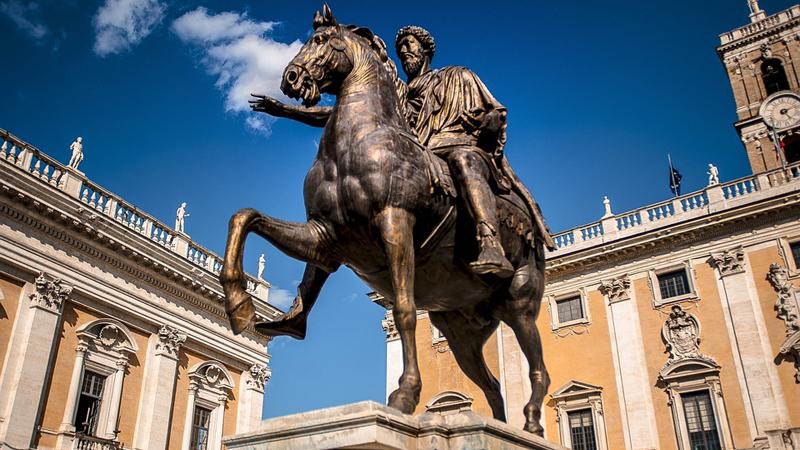
Marcus Aurelius (A.D. 121-80), the adopted son of Roman Emperor Pius, ruled the empire for 20 years until his death. Shortly before his death, an unknown sculptor created the now famous statue of the emperor riding a horse.
Originally the statue was placed in the Piazza outside his office in the City Hall. The large monument was 14-feet tall and 13-feet long from the horse’s muzzle to its tail. The rider’s face recaptured the emperor’s serenity which was his dominant trait.
The statue had a broad forehead and wide-open eyes that gazed calmly at an imaginary crowd. His outstretched right arm is raised in a gesture of an orator. The curly hair and well-trimmed beard gave a majestic look to his face. He held something in his right hand, probably an emblem of authority.
Even in medieval times, there were vandals and image-smashers. However, they spared the statue thinking that it was the image of the Christian Emperor Constantine. After some time the statue was moved away from its original location to the Capitoline Hill.
Once planted there, it was raised skyward by a marble pedestal designed by Michelangelo. Thereafter, the statue became a landmark for Rome like the Eiffel Tower for Paris. However, there were protests against the removal of the statue from the Piazza.
Although modern sculptors can cast a large sculpture in one piece, the emperor’s statue was cast in 25 segments. On April 20, 1979 something unfortunate happened to the statue when a terrorist bomb exploded in Rome’s Capitoline Hill.
Although the blast did not affect the statue, centuries of wind, rain and cold adversely affected it. Experts were called in to restore the statue. A restorer said, “All Rome was breathing down our necks.”
Restoration
The restoration of the statue took more than three years. A large number of devices such as an X-ray machine, metallographic microscope, ultrasound scanners and infrared cameras had to be used. The restorers took ultrasonic measures of the horse’s body structure and examined the narrow passage in Marcus’s fingers and the horse’s ears with an endoscope.
Thereafter, they fed the details into a computer. A chemist who examined the statue said the statue had been attacked by humidity. A physicist who was called in made a bronze replica of the emperor’s horse to determine what strains and stresses the original could have tolerated.
Painstaking efforts of the restorers reached the climax in 1987. The restorers took every possible precaution to preserve the monument for the future generations. Their knowledge of anatomy transformed the monument into a vibrant image.
Today, it stands as a peerless masterpiece reminiscent of the ancient Imperial Rome. To avoid any damage from environmental factors, the monument was later moved into the Capitoline Museum.
Although there had been many eminent Roman Emperors, Marcus Aurelius was a unique emperor because he was, perhaps, the only ‘Philosopher King’ the world has produced.
He wrote ‘Meditations or writings to himself’ in the midst of the Parthian War. Being a converted Stoic he had a great concern for the social problems of the poor, slaves and prisoners. He considered the Christian population as a threat to the Roman religion and their way of life.
Stoic philosophy
‘Meditations’ was a loosely organised set of ideas relating to Stoic philosophy. Stoicism was a philosophy closer to religion. According to ‘Meditations,’ the happiness of your life depends on the quality of your thoughts. Therefore, you have to guard yourself accordingly and take care that you entertain no notions unsuitable to virtue and reasonable nature.
Aurelius believed that a divine providence had placed reason in man and it was in the power of man to be one with the rational purpose of the universe. The Stoic philosophy was primarily concerned with living in accordance with your own universal nature. This was best understood by Taoist philosophers.
Simple living and contentment with your lot go hand in hand with Stoicism and Buddhism. Stoicism was considered a religion as a means of social control.
For instance, a ruler does not have to worry about anything if people get what they want.
The emperor may not have depended heavily on Stoicism to rule his mighty empire. Stoics insisted on living in accordance with nature. However, people had to strive towards self-preservation which leads to living in tune with nature.
Stoics insisted on seeking intellect in addition to food, warmth and shelter. They believed that virtue included wisdom, justice, courage and moderation.
Philosopher King
In ‘Republic’, the celebrated Greek philosopher Plato argued that the ideal city state should be ruled by a ‘Philosopher King.’ Since then many world leaders have tried to claim that title in vain. Centuries later Marcus Aurelius earned the coveted title of ‘Philosopher King’ by ruling the mighty Roman Empire for 20 years.
His philosophy of ruling a state is reflected in his ‘Meditations.’ It was essentially a notebook he used to leave his personal reflections. He most likely never intended to publish it or to be read by anyone else. However, the tiny book has left us a lasting legacy.
Marcus Aurelius gave proof of his knowledge not by high-sounding words but by showing his knowledge of philosophical doctrines and his blameless character and temperate way of life.
During his tenure as the emperor, the Roman Empire produced a large number of intelligent men. If any ruler or ordinary person wishes to be influenced by ‘Meditations’ here is a quotation for them to read:
“Don’t be anxious about the future. You’ll come to it (if you must), equipped with the same reason that you apply to the present.”
